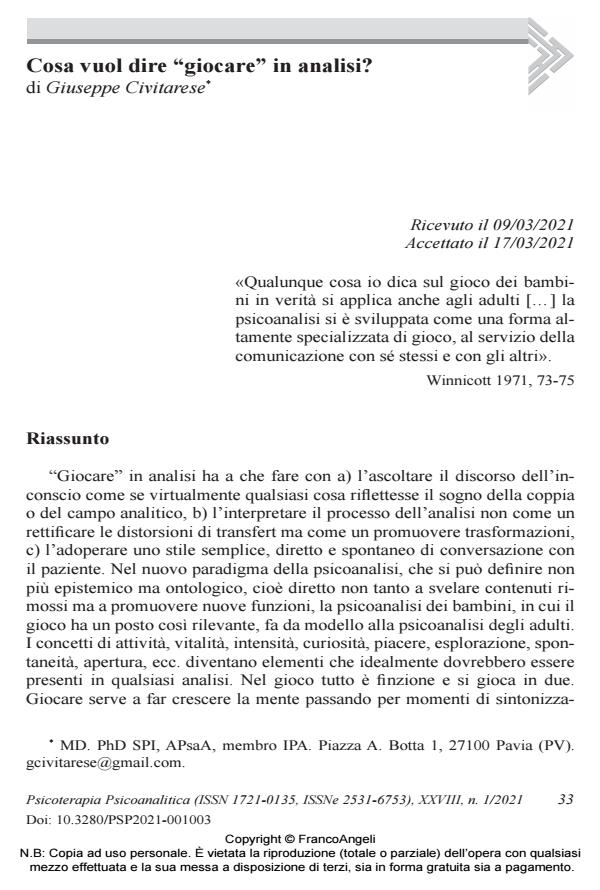What does playing in analysis mean?
Journal title PSICOTERAPIA PSICOANALITICA
Author/s Giuseppe Civitarese
Publishing Year 2021 Issue 2021/1 Language Italian
Pages 23 P. 33-55 File size 239 KB
DOI 10.3280/PSP2021-001003
DOI is like a bar code for intellectual property: to have more infomation
click here
Below, you can see the article first page
If you want to buy this article in PDF format, you can do it, following the instructions to buy download credits

FrancoAngeli is member of Publishers International Linking Association, Inc (PILA), a not-for-profit association which run the CrossRef service enabling links to and from online scholarly content.
"Playing" in analysis has to do with a) listening to the discourse of the unconscious as if virtually everything reflected the dream of the couple or the analytic field, b) interpreting the process of analysis not as rectifying transference distortions but as promoting transformations, c) using a simple, direct and spontaneous style of conversation with the patient. In the new paradigm of psychoanalysis, which can be defined no longer as epistemic but as ontological, that is directed not so much to unveiling repressed contents as to promoting new psychic functions, the psychoanalysis of children, in which play has such an important place, serves as a model for the psychoanalysis of adults. The concepts of activity, vitality, intensity, curiosity, pleasure, exploration, spontaneity, openness, etc., become elements that ideally should be present in any analysis. In the game everything is fiction and it is played in two. Playing serves to make the mind grow through moments of emotional attunement (at-one-ment). Hence the need for the analyst to have up-to-date concepts in order to understand what is happening on the unconscious and shared level of the relationship.
Keywords: play, Bion, analytic field theory, transformation in play, at-onement, recognition.
- Bion W.R. (1959). Attacchi al legame. In Riflettendoci meglio [1967] Roma: Astrolabio-Ubaldini, 2016.
- Bion W.R. (1962). Apprendere dall’esperienza. Roma: Armando, 1972.
- Bion W.R. (1967). Riflettendoci meglio. Roma: Astrolabio-Ubaldini, 2016.
- Bion W.R. (1975-1979). Memoria del futuro. Vol. III. Milano: Raffaello Cortina, 1996-2006.
- Civitarese G. (2008). Immersion Versus Interactivity and Analytic Field. International Journal of Psychoanalysis, 89: 279-298. DOI: 10.1111/1745-8315.2008.00019
- Civitarese G. (2015). Transformations in Hallucinosis and the Receptivity of the Analyst. International Journal of Psychoanalysis, 96: 1091-1116. DOI: 10.1111/1745-8315.12242
- Civitarese G. (2016). Truth as Immediacy and Unison: A New Common Ground in Psychoanalysis? Commentary on Essays Addressing “Is Truth Relevant?”. Psychoanalytic Quarterly, 85: 449-501. DOI: 10.4324/9781315146461-9
- Civitarese G. (2018). Soggetti sublimi. Esperienza estetica e intersoggettività in psicoanalisi. Udine-Milano: Mimesis.
- Civitarese G. (2018). Traduire l’expérience: le concept de transformation dans Bion et la théorie du champ analytique. Revue Française de Psychanalyse, LXXXII(5): 1327-1386.
- Civitarese G. (2019a). Bion’s O and His Pseudo-Mystical Path. Psychoanalytic Dialogues, 29: 388-403. DOI: 10.1080/10481885.2019.1632649
- Civitarese G. (2019b). On Bion’s Concepts of Negative Capacity and Faith. Psychoanal. Quarterly, 88(4): 751-783. DOI: 10.1080/00207578.2019.1570216
- Civitarese G. (2020a). Plea for a safe place. Journal of the American Psychoanalytic Association, 68(6): 1143-1154. DOI: 10.1177/0003065120980137
- Civitarese G. (2020b). On Bion’s Graph of “in Search of Existence”. The American Journal of Psychoanalysis, in stampa.
- Civitarese G. (2020c). Regression in the Analytic Field. Romanian Journal of Psychoanalysis, 13: 17-41. DOI: 10.4324/9780429481048-9
- Civitarese G. (2020d). Book Review I and You, by Donald Moss. International Journal of Psychoanalysis, 101: 217-221. DOI: 10.1080/00207578.2019.1655430
- Civitarese G. (2020e). Intersubjectivity and Analytic Field. Journal of the American Psychoanalytic Association, in stampa.
- Civitarese G. (2020f). Experiences in Groups as a Key to “Late” Bion. International Journal of Psychoanalysis, in stampa.
- Civitarese G. (2021). The limits of interpretation. A reading of Bion’s “On Arrogance”. International Journal of Psychoanalysis, 102: 236-257. DOI: 10.1080/00207578.2020.1827954
- Civitarese G. (2021). Invisible-Visual Hallucinations in Bion’s Attacks on linking. Manoscritto inedito.
- Civitarese G., Berrini C. (2021). On using Bion’s concepts of point, line, and linking in the analysis of a 6-year-old borderline child. Psychoanalytic Dialogues, in stampa. Eco U. (1963). Diario minimo. Milano: Mondadori.
- Ferenczi S. (1931). Una revisione dell’interpretazione dei sogni. In Opere, Vol. IV. Milano: Raffaello Cortina, 2021.
- Ferro A. (1992). La tecnica nella psicoanalisi infantile. Il bambino e l’analista: dalla relazione al campo emotivo. Milano: Raffaello Cortina.
- Freud S. (1907). Il poeta e la fantasia. In OSF, 5.
- Freud S. (1920). Al di là del principio di piacere. In OSF, 9.
- Gadamer H.-G. (1975). Verità e metodo. Milano: Bompiani, 1988.
- Genta F. (2021). Le moment poétique en séance comme possible émergence du O Bionien. Conferenza alla Società svizzera di psicoanalisi il 13 marzo 2021.
- Hegel G.W.F. (1807). Fenomenologia dello spirito. Torino: Einaudi, 2014.
- Heidegger M. (1927). Essere e tempo. Milano: Longanesi, 2001.
- Heidegger M. (1950). L’origine dell’opera d’arte. In Sentieri interrotti. Firenze: La Nuova Italia, 1968.
- Kristeva J. (1975). La rivoluzione del linguaggio poetico. Milano: Spirali, 2007.
- Le Guen C. (1970). Dizionario freudiano Roma: Borla, 2013.
- Merleau-Ponty M. (1968). Linguaggio, storia, natura. Corsi al Collège de France, 1952-1961, Milano: Bompiani, 1995.
- Ogden T.H. (2009). Sul parlare come sognare. L’Annata Psicoanalitica Internazionale, 5: 127-141.
- Pasqualin C. (2015). Il fondamento “patico” dell’ermeneutico. Affettività, pensiero e linguaggio nell’opera di Heidegger. Roma: Inschibboleth.
- Pound E. (1934). L’ABC del leggere. Milano: Garzanti, 2012.
- Weinshel E. (1988). Play and Playing in Adults and in Adult Psychoanalysis: An Addendum to the Paper “On Inconsolability”. Bulletin of the Anna Freud Centre, 11: 108-127.
- Percepire il cambiamento, percepire la continuità: note sull'autoanalisi Adriana Gagliardi, in PSICOTERAPIA PSICOANALITICA 2/2021 pp.29
DOI: 10.3280/PSP2021-002003
Giuseppe Civitarese, Cosa vuol dire "giocare" in analisi? in "PSICOTERAPIA PSICOANALITICA" 1/2021, pp 33-55, DOI: 10.3280/PSP2021-001003